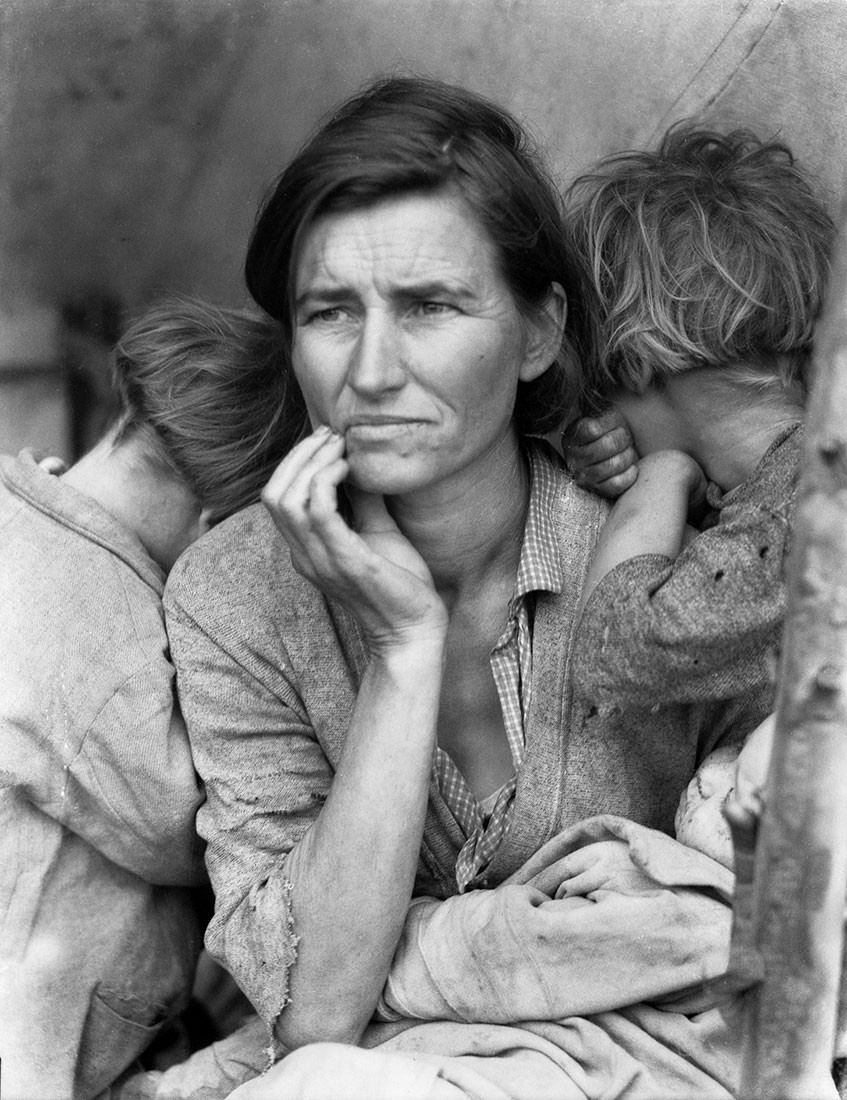Dorothea Lange
16 Oct 2018 - 27 Jan 2019

Dorothea Lange - Mère migrante, Nipomo, Californie, 1936
© The Dorothea Lange Collection, the Oakland Museum of California, City of Oakland
© The Dorothea Lange Collection, the Oakland Museum of California, City of Oakland
DOROTHEA LANGE
16 October 2018 – 27 January 2019
Curator: Drew Heath Johnson and Pia Viewing
Drawing from the archives of the Oakland Museum of California, this is the first exhibition to focus on the extraordinary emotional power of Dorothea Lange’s work and to present her work produced during the Great Depression, the Second World War and post-war America, from the perspective of her political activism.
Along with the writings of John Steinbeck, Dorothea Lange’s photographs are an example of great works of art inspired by hard times: an image like Migrant Mother takes on a mythical dimension by becoming the symbol of an entire era. When the Great Depression struck in 1929, Lange instinctively turned her lens towards the victims of the recession and took photographs that would attract the attention of individuals like Paul S. Taylor, a labour economist at the University of California. The two quickly became a couple and began a collaboration, documenting the plight of struggling workers in the Dust Bowl for the governmental agencies of the New Deal. The Dust Bowl was situated in the heart of America’s agricultural region, in the Midwest, and was ravaged by drought and terrible dust storms.
Following the Great Depression, Dorothea Lange continued to practise photography and to document the major issues of the day, including the internment of Japanese-American families during the Second World War; the wartime migration of African-American and Hispanic families to California; the criminal justice system through the work of a county public defence lawyer, as well as environmental destruction and urban development in the post-war years.
If Dorothea Lange’s iconic images of the Great Depression are well known, her photographs of Japanese-Americans interned during the war were only published in 2006, when they were shown for the first time, in France, in an exhibition at the Jeu de Paume. They perfectly illustrate how Dorothea Lange made use of intimate and poignant images throughout her career, to denounce injustices and change public opinion.
Almost 130 photographs are organized by theme so as to better demonstrate the connections between Lange’s photography and her socio-political activism. In addition, a selection of personal items, including unedited contact sheets, field notes, historic objects and videos allow the public to situate her work within the context of this troubled period.
The exhibition at the Jeu de Paume examines from a new perspective the work of this renowned American artist, whose legacy continues to be felt today. Highlighting the artistic qualities and the strength of the artist’s political convictions, this exhibition allows audiences to rediscover the importance of Dorothea Lange’s work.
16 October 2018 – 27 January 2019
Curator: Drew Heath Johnson and Pia Viewing
Drawing from the archives of the Oakland Museum of California, this is the first exhibition to focus on the extraordinary emotional power of Dorothea Lange’s work and to present her work produced during the Great Depression, the Second World War and post-war America, from the perspective of her political activism.
Along with the writings of John Steinbeck, Dorothea Lange’s photographs are an example of great works of art inspired by hard times: an image like Migrant Mother takes on a mythical dimension by becoming the symbol of an entire era. When the Great Depression struck in 1929, Lange instinctively turned her lens towards the victims of the recession and took photographs that would attract the attention of individuals like Paul S. Taylor, a labour economist at the University of California. The two quickly became a couple and began a collaboration, documenting the plight of struggling workers in the Dust Bowl for the governmental agencies of the New Deal. The Dust Bowl was situated in the heart of America’s agricultural region, in the Midwest, and was ravaged by drought and terrible dust storms.
Following the Great Depression, Dorothea Lange continued to practise photography and to document the major issues of the day, including the internment of Japanese-American families during the Second World War; the wartime migration of African-American and Hispanic families to California; the criminal justice system through the work of a county public defence lawyer, as well as environmental destruction and urban development in the post-war years.
If Dorothea Lange’s iconic images of the Great Depression are well known, her photographs of Japanese-Americans interned during the war were only published in 2006, when they were shown for the first time, in France, in an exhibition at the Jeu de Paume. They perfectly illustrate how Dorothea Lange made use of intimate and poignant images throughout her career, to denounce injustices and change public opinion.
Almost 130 photographs are organized by theme so as to better demonstrate the connections between Lange’s photography and her socio-political activism. In addition, a selection of personal items, including unedited contact sheets, field notes, historic objects and videos allow the public to situate her work within the context of this troubled period.
The exhibition at the Jeu de Paume examines from a new perspective the work of this renowned American artist, whose legacy continues to be felt today. Highlighting the artistic qualities and the strength of the artist’s political convictions, this exhibition allows audiences to rediscover the importance of Dorothea Lange’s work.
